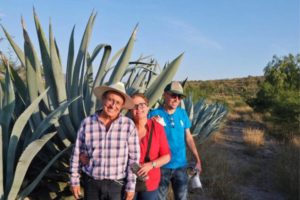Land degradation is recognized as one of the world’s most pressing environmental problems, with about a quarter of the world’s total land area already degraded, according to the Global Environment Facility (GEF). This adverse land-use change has seriously harmed the livelihoods of more than 3 billion people, almost 40% of the world’s population while exacerbating climate change due to the release of long-sequestered soil carbon and nitrous oxide – a powerful greenhouse gas – into the atmosphere.
Worse may lie ahead. Scientists warn that 24 billion tons of fertile soil are being lost each year, largely due to unsustainable agriculture practices. If this trend continues, they say, 95% of Earth’s land area could be degraded by 2050 – a dangerously unsustainable situation.
However, practical solutions exist, according to Gary Nabhan, a professor at the University of Arizona and one of the world’s leading experts on farming on arid land. “Over the last 50 years, most top-down rural development projects, have failed terribly,” he explains. “But there are guys trying out new ideas at the margins of conventional agriculture, which is where all lasting innovations in agriculture come from. We have to listen to them.”
Now a new initiative offers a way forward to these families. It is the brainchild not of a high-tech company or government, but of a local farmer, José Flores Gonzalez, who, with his two brothers, runs a farm in the municipality of Luis de La Paz, which borders San Miguel de Allende. Their farm once covered 1,000 hectares (about 2,500 acres), but little by little the family was forced to sell parcels until they were left with a tenth of its original size.
Like so many others, the three brothers sought employment away from their farm. Flores Gonzalez studied mechanical engineering and became a lecturer at a local university.
As the years passed, the land degradation and drought situation in the vast semiarid region worsened. With few options, families overgrazed their pastures, trying to squeeze out what subsistence livelihood they could – wearing out the land even more. Francisco Peyret, the San Miguel de Allende municipality environment and sustainability director, says the scale of the calamity is evident to everyone: “Some of the areas around here look as if they’re on Mars. They really have no soil.”
Growing all around: ‘The world’s cheapest fodder’
Flores Gonzalez lamented a predicament that had become desperate not only for his family but his neighbors. But he didn’t despair. Instead, he worked to take advantage of his academic training and harness the peculiar growing habits of the few hardy plants that flourish on the region’s dry, degraded lands. Eventually, he found a way to restore the ecosystem and potentially revive the peasant farm community economy.
Ronnie Cummins, founder of the Organic Consumers Association – who today spends most of the year in San Miguel de Allende working with Via Orgânica, the Mexican branch of the NGO Regeneration International – remembers his sudden excitement when he realized what Flores Gonzalez had envisioned.
“We were teaching a workshop on compost” in 2019, Cummins recalls. “Afterwards a scientist, Juan Frias, came up to me and told me that three brothers had developed a revolutionary new system of intercropping agave with mesquite trees to produce ‘the world’s cheapest fodder,’” which was also able to sequester “carbon from the air.” It seemed almost too good to be true, but Flores Gonzalez had discovered something quite new.
Agave and mesquite are both common native plants to Mexico’s semiarid lands. Indigenous populations have used agave maybe for millennia, making alcoholic beverages out of it, such as tequila, pulque, and mescal. Mesquite pods have traditionally been used to make atole, a beverage popular during Mexico’s Day of the Dead festivities.
The two plants survive in the desert in very different ways. Agaves, known as maguey in Mexico, have shallow root systems and draw moisture directly from the air, storing it in their thick, thorny leaves, known as pencas. Unlike a lot of plants, they absorb most of their carbon dioxide at night. This means that far less water evaporates off the leaves through transpiration, allowing the plant to produce significant amounts of biomass, even under conditions of severely restricted water availability and prolonged drought.





Leave a Reply